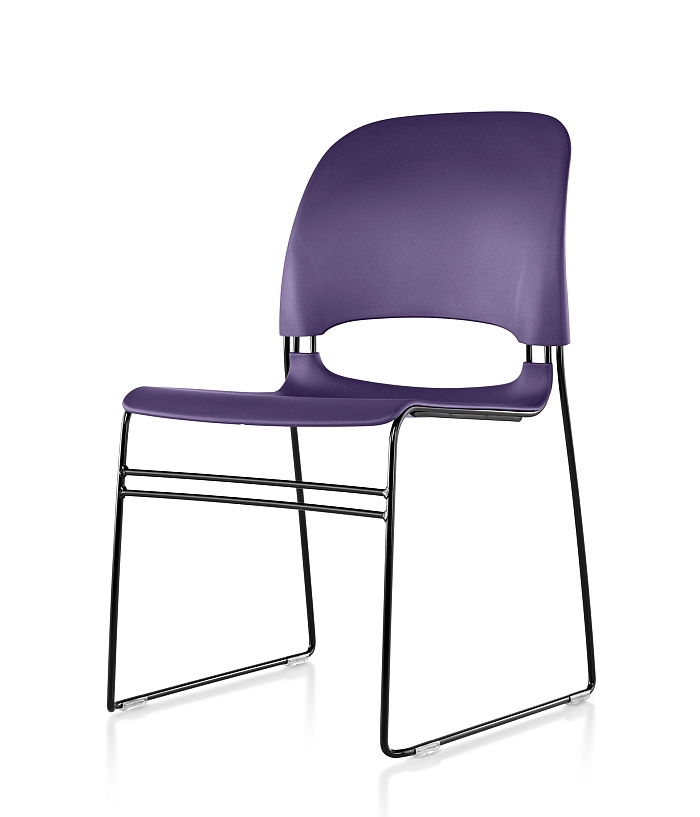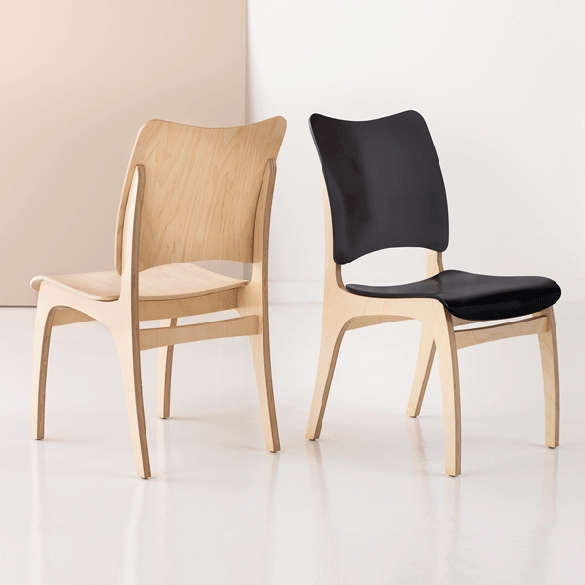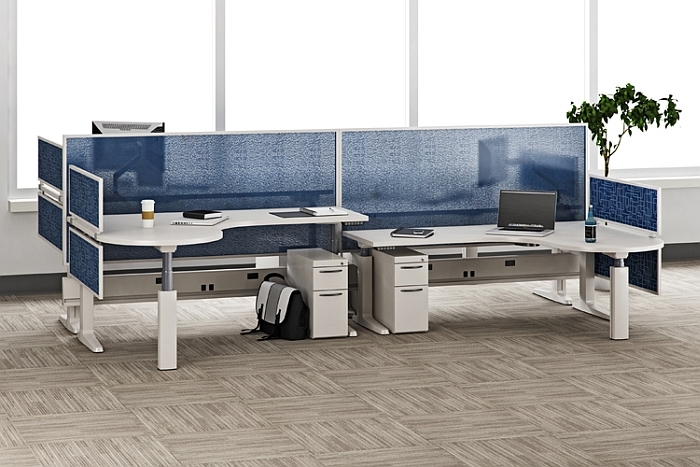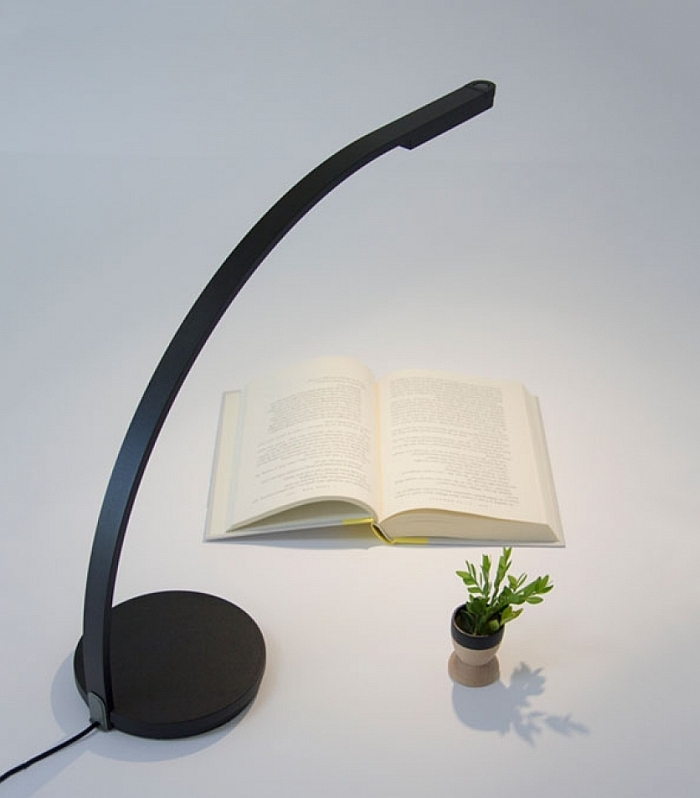Born and raised in Grand Rapids, Michigan, a town famous for some 150 years as a, if not the, centre of American furniture production, it is perhaps not surprising that Tom Newhouse choose to pursue a career in furniture design. Upon graduating in 1972 from the School of Art and Design at the University of Michigan in Ann Arbor, Tom Newhouse took up a position as a staff designer with Herman Miller, a situation he himself refers to as a "marvellous beginning", before in 1978 he established his own studio in, where else, Grand Rapids. His first job as a freelancer however came from his former employer with the commission to redesign Herman Miller's European showrooms; a commission which saw him, albeit briefly, leave West Michigan to spend three years in Europe, and an experience which allowed him to gain first hand insights into the European office furniture market and culture.
In addition to his numerous co-operations with Herman Miller Tom Newhouse has also developed furniture and lighting projects for and with manufacturers as varied as, and amongst many others, Worden, Philips and JRB Studio, and currently holds some 90 patents.
Long an advocate of sustainable design in 1996 Tom Newhouse created with the Limerick Chair Herman Miller's first 99+% recyclable chair - technically 100% save a little powder coating which burns off when melting the steel - and has lectured on the subject at institutions around the globe.
We met up with Tom Newhouse at NeoCon Chicago 2016 to discuss sustainable design, chauffeuring George Nelson and his role in the development of the infamous office cubicle systems, but started, as ever, by asking why design?
Tom Newhouse: I was always sketching/drawing pictures of cars, planes, boats, etc. when I was child. I am told that I naturally drew in perspective when I was 2-3 years old. My 6th grade teacher had a brother who was an industrial designer, he told my parents about that profession....and I was hooked at 11 years of age. I simply love the creative process, combining aesthetic beauty, sustainability, ergonomics and affordability into truly useful things.
smow blog: Your first job was with Herman Miller, something you refer to as being a "marvellous beginning", how did that beginning arise, was that an advertised vacancy or something arranged through college......
Tom Newhouse: No, no, I saw an advertisement for Eames furniture and I said "Whoever makes that, I want to work with that company!" And as it turned out it was only 20 miles from where I was born. At that time they didn't have an opening but the Director of Design Bob Blaich created one for me and I was fortunate enough to work with Charles and Ray Eames and George Nelson in their emeritus years, which was a wonderful experience.
smow blog: And if we're correctly informed you were also George Nelson's chauffeur?
Tom Newhouse: Yes, at the time his health wasn't so good but he had not only been such a central part of Herman Miller for so long, but was still an important voice in the company, and so would regularly come to Zeeland to view and critique the new projects.
smow blog: And was he a harsh critic?
Tom Newhouse: Tough but fair, although probably not as hard as Charles Eames, he was probably a little harsher in his criticism.
smow blog: And we presume that as a young designer one can only learn from spending time with someone such as Nelson.....
Tom Newhouse: Absolutely, a huge amount. Among other experiences I was lucky enough to accompany him to the design conference in Aspen and there we got to spend an awful lot of time discussing things with him. He was a very wise man, a very sharp critic and very magnanimous. One should never forget that Nelson was taken on to design for Herman Miller, but he told D. J. DePree [company founder and CEO] there are these brilliant designers, Charles and Ray Eames, they are in Los Angeles, but you really need to get to know them because they are doing really great work. And D. J. replied OK, but you're giving away work, to which Nelson replied, yeah, but they're doing things I can't do!
smow blog: And in addition to chauffeuring George Nelson around Michigan, were you actually designing yourself or what was your role in the company?
Tom Newhouse: Herman Miller generally work with external designers, and always have, George Nelson for example always lived in New York, Charles and Ray always lived in LA, Bill Stumpf was based in Minnesota, but they tend to have staff designers who assist locally. Which was my job. And so for three of the six years I was part of the facilities and exhibits team and for the other three years I was part of the Action Office team working in-house for Bob Propst who was based in Ann Arbor.
smow blog: Which means you're partly to blame for the cube farms.......
Tom Newhouse: ....yeah I'm partly to blame! We started with Bob Propst's wonderful 64 part system, a system which we then developed into thousands of parts, way too many parts, and which became the famous "Dilbert" system. Propst never wanted all those parts, he wanted a limited number of parts, and most importantly he never wanted a rigid box, every connection in his system was hinged, and he was in favour of being able to create random, hinged shapes to meet specific needs.
smow blog: So why did we end up with rigid, square cubicles, and Dilbert?
Tom Newhouse: My opinion is that facility managers cramming more people into boxes made everything quadratic. The demands of the economics of space. Facility managers realised that with square cubicles they could cram more people into a given space, and then over time reduce the size of the cubicle and cram even more people in. And we kept developing new components because people were asking for them. But the end result was far removed from Propst's original intention for flexible work spaces.
smow blog: And did that work on the Action Office also involve Nelson, or was he out of that project by then....?
Tom Newhouse: George Nelson styled Action Office 1 because Propst was an inventor not an industrial designer and didn't really have any aesthetic skills, and so the Nelson Office did all the styling, and in my opinion didn't do a particularly good job. For me Action Office 1 wasn't a particularly good product, was pretty, but terribly expensive and structurally poor, and so there wasn't a good marriage between Nelson and Propst. Consequently for Action Office 2 the cooperation was much more between Propst and Jack Kelly, who had worked with Propst for many years before he became Director of Design at Herman Miller, and so Action Office 2 was much more a Herman Miller project.
smow blog: After leaving Herman Miller you established your own studio in Grand Rapids, the famous "Furniture City USA". As a designer is contemporary Grand Rapids a good place to be based?
Tom Newhouse: It's a great place, for all if you don't want to travel as you've a lot of potential clients nearby, about half of the American office furniture industry is located within a twenty mile radius, the rest is scattered across the country. But more importantly for me it is really strong in terms of materials and processing, whether you want injection moulded plastics, stamped steel, die-casting, whatever, it's all there and that at a very sophisticated level. Consequently you have state of the art expertise as it applies to commercial furniture production, right on your doorstep, and that's not something you have everywhere in America. It's probably not all positive, there is a risk of it becoming incestuous when everybody talks to and cooperates with everyone else in a twenty mile radius, but on the other hand it is fantastic because you have excellent possibilities, can build things and also have a lot of local engineering experience.
smow blog: Something which of course isn't unimportant when considering office furniture....
Tom Newhouse: Absolutely. My preferred approach is always to work with a great engineering partner. I'm an industrial designer, I define the aesthetics, but benefit from having someone with a better technical and material understanding, and then when the client is already selected you can really win......
smow blog: Another of your preferred approaches is to work is sustainability.....
Tom Newhouse: ....yes, yes, from very early on I was a green, sustainable, kind of freak, consequently sustainable, ecological, design has always been at the core of what I do and my approach to my work has always been that aesthetics, sustainability, ergonomics and economy must be in equilibrium, if they aren't the design isn't finished.
smow blog: And was that something that developed during your studies, or.....?
Tom Newhouse: I had a Professor at Michigan, Aare Lahti, who was an American of Finnish extraction, and he had a strong interest in the correlation of materials, processes and the planet, and so from very early on I was being taught about efficient use of materials. And then at that time, in the late 1960s, the campuses were burning with radical thought, the green movement was born and I was right there, met my future wife there, and so I was present at a moment in time that made perfect sense to me, and for example, I built our house and studio in 1978, and it's low-energy consumption and has always had a green roof.
smow blog: And when you look at the contemporary American furniture industry do you see "sustainability"?
Tom Newhouse: In the sector as represented here at NeoCon it's become normal, in contemporary office furniture sustainability is an absolute requirement. In essence a lot of the thinking behind LEED certification, green buildings, sustainable planning and the like has permeated into the thinking about what stands inside buildings, and thus the buyers of office furniture are much more aware of, and demanding of, sustainability.
smow blog: And with home furnishings?
Tom Newhouse: Home furnishings is different, in home furnishings they are way behind. Many Americans buy in a very temporal way, and so in terms of home furnishings they buy something and not only throw it away when it breaks, but expect it to break. In addition there is very little appreciation of the design, for many Americans the design isn't particularly interesting. Consequently I've rarely designed for the domestic market. Office furniture is completely different, operates at a much higher level and demands a higher level of quality and sustainability.
smow blog: Which we presume has changed the ball park for yourself?
Tom Newhouse: Most definitely. I used to have to sneak my ideas into the design and not say anything to the company involved, then about fifteen years or so ago the companies started to tolerate it - but only if it didn't cost any more! And now as I said it is a requirement, and I love it!
More information on Tom Newhouse and his work can be found at www.thomasjnewhouse-design.com



